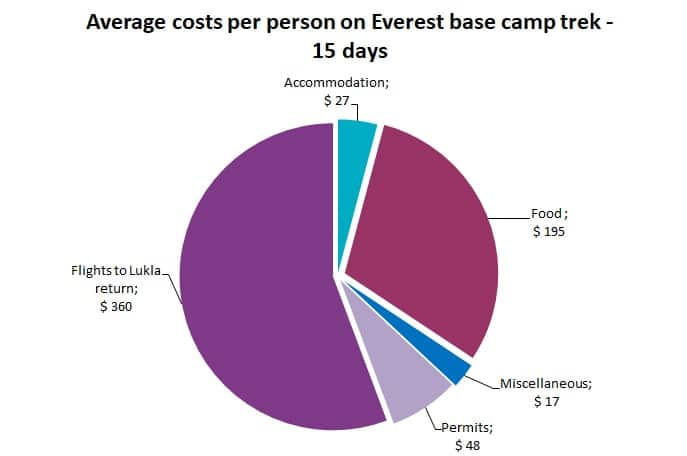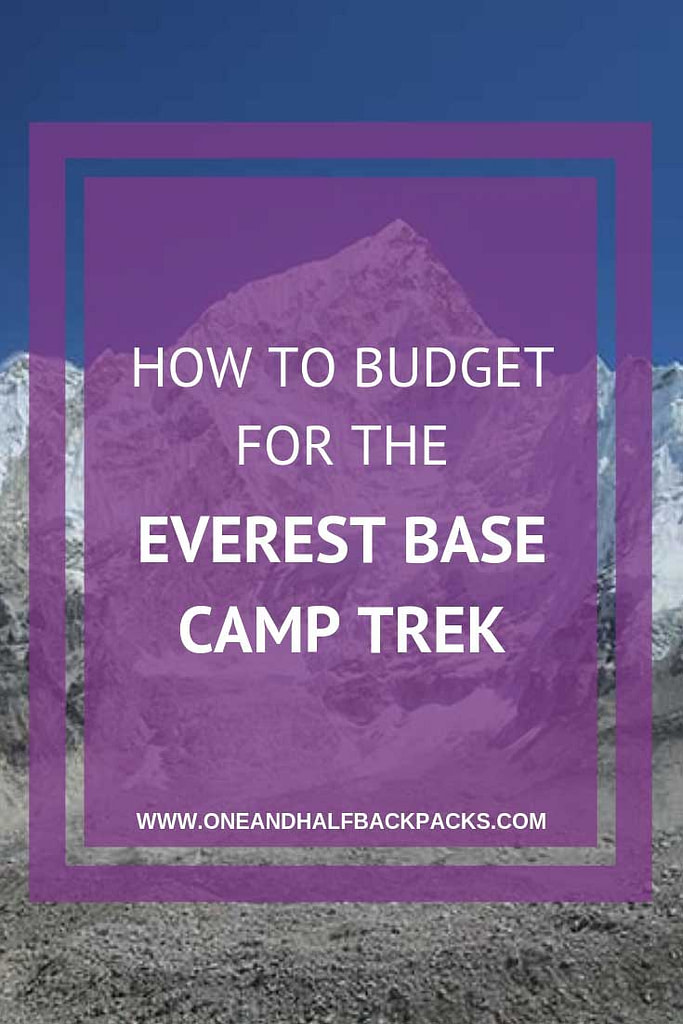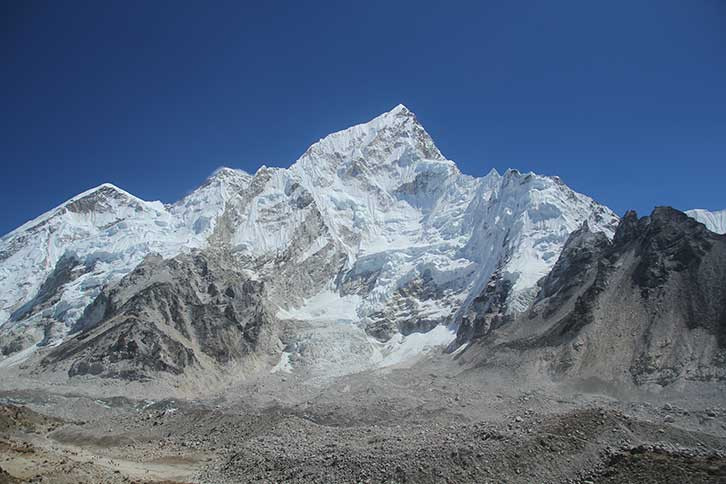In this post, we have broken down all the expenses for our 15-day Everest Base camp trek, including accommodation, food, flights and all the permits. We were able to lower our expenses by going independently without hiring any guide or a porter.
Before our departure, we were not sure how to plan a budget for the Everest base camp trek. Let alone if we will be able to do the famous Everest base camp trek on a small budget. But after what we had read on the internet we finally decided to plan to stay under $50 a day per person, if possible.
Definitely, among the highest costs belong the flights from Kathmandu to Lukla and all the permits.
Read more about the Lukla airport! The honest truth that no one is talking about!
But after paying those initial expenses we were surprised that the Everest base camp trek is not that expensive. The Everest base camp trek can surely be done on a low budget especially if you decide not to fly to Lukla and walk to Namche Bazar instead.
But let´s have a look at the average expenses that you can expect on the Everest base camp trek.
Note: Don´t forget to bring rupees with you on the Everest base camp trek. There are very limited options to withdraw money along the trail. Plus all the accommodation and food need to be paid in rupees. The only ATM that you will find on the trek are in Lukla and Namche Bazar. It is much safer to bring cash with you.
The budget for the Everest base camp trek for a couple
Total days spend on the Everest base camp trek: 15 day
Average daily trek costs per couple:
- Accommodation: $4
- Food: $23
- Miscellaneous: $3
So on average, we spend on the trek: $30 a day per couple
- Flights: $720 (two return tickets)
- Permits: $95
Total costs: $1 293
Average costs: $43 per day per person


Accommodation on the Everest base camp trek
- The accommodation in teahouses along the Everest base camp trek is cheap. On average we spent just $4 per night per couple. The prices for accommodation rises as you get higher. With the highest prices for the night in Lobuche and Gorak Shep.
- You can expect to pay between 200 – 700 rupees for a room in the most teahouses. Up to 4 000 metres, the accommodation usually cost 200 – 500 rupees per night. Above 4 000 metres, price per room rises between 500 – 700 rupees per night.
- Our most expensive accommodation was in Lobuche and Gorak Shep, where night cost $7 a night.
Note: In Lobuche and Gorak shep there is a central system for paying for accommodation. You don´t pay for accommodation directly in the lodges. Actually, when you come to the village you will see a checkpoint, where you are required to pay a fee. Lobuche charged us 700 rupees, as well as Gorak Shep. But the next day someone told us that they paid just 500 rupees in Gorak Shep, so maybe we overpaid. After paying that fee you will obtain a ticket that gives you the option for a room. With this ticket in your hands, you just choose a lodge, present the ticket and get a room.
- Most accommodation is very cheap because the owners don´t make a profit on renting those rooms. All lodges require you to eat in the restaurant that is attached to the lodge you stay in. Otherwise, they will charge you more on the room. After a few nights we realized that all the rooms in the lodges look kind of the same, so we started to choose the lodges according to their menu more than rooms. A nice bonus was when the lodge had a normal toilet.
- Sometimes you will be even able to find teahouses that charge nothing for accommodation if you eat in their attached restaurant.
- Most of the rooms look the same. They offer two beds or a double bed, maybe a nightstand and a few hooks where you can hang your jackets. None of the rooms has power sockets. Most of the rooms don´t have their own bathrooms so expect the shared bathrooms and toilets.
Food on the Everest base camp trek
- As you can see from our budget above we spent most money during the Everest base camp trek on food. Before the trek, we definitely budget a little bit less to spend on food, but we were simply hungry. Also, food was a way how to warm ourselves after completing the trek for a day.
- On the other hand, we saved a lot of money on occasional snacking because we brought our own snacks from Kathmandu. Chocolate and nuts bar are quite cheap in Kathmandu and they don´t take a lot of space in your backpack.
- We were quite surprised at how cheap the food in the lodges was. Also, to our surprise lodges offered quite an extensive menu. When we started the trek we were mentally ready to eat just Dal Bhat for 14 days as we expected to find very limited menu offers. But almost all lodges offer a wide variety of food, from momos to pasta, potatoes dishes, soups and Nepali specials like Dal Bhat. Some lodges even offer pizzas and steaks.
- It is wise going for vegetarian dishes, though, while being in the mountains. The reason number one is that vegetarian dishes are usually cheaper. But the main reason for going vegetarian is that Nepali people are not allowed to kill animals in the mountains due to religious reasons. Therefore all animals are killed in the valleys and the meat is carried into the mountains afterwards. So especially in high altitudes, the meat is not that fresh as you might expect.
Water and drinks on the Everest base camp trek
- We saved a lot of money by not buying bottled water on the Everest base camp trek. Instead of buying the bottled water we had purchased the water purification tablets to clean our water. If you decide to buy bottled water during your trek, expect to pay between 70 – 400 rupees. The prices rise as you go up. The bottle of water cost around 80 rupees in Lukla and 400 rupees in Gorak Shep.
- There is no shortage of water along the trek, you can fill up your bottles in teahouses as well as in the rivers. We find that the water purification tablets worked the best for us, but you can use Steripen or Lifestraw for cleaning your water instead. Nonetheless, in Gorak Shep, there is no river and all water supplies are far away. So water has to be brought to this village by sherpas. That is why there is no chance to refill your water there. It was the only place during the whole trek where we had to buy the bottled water.
- We did not spend any money on alcohol, because first, it is expensive and second, it is not recommended to consume alcohol above 3 000 meters.
- Lodges usually offer few local beers as well as Heineken beer. The local beers cost between 350 – 600 rupees. A glass of wine usually cost 500 rupees. Of course, as you go up, the prices for alcohol skyrockets.
Miscellaneous on the Everest base camp trek
- We have a confession to make 🙂 We did not shower for 14 days, not because we are that cheap and did not want to pay for a shower, but because we were that cold. After Namche Bazar, the temperature dropped significantly. For us, even the idea of taking off our clothes was so intimidating that we just decided to wait to shower until we are back.
- The prices for a hot shower varies as well as a possibility to get hot water. Lodges usually charged around 300 to 600 rupees for a hot shower. But you are not guaranteed to actually get a hot water. We met people who paid $10 for a shower and got just a cold water. But is anyone surprised? Getting the hot water in the altitude above 3 000 meters is difficult because some of the lodges get their power just from solar panels.
- We spend probably $10 on the Wi-Fi during the trek. Lukla offers free wifi in almost every lodge. But as you go higher, wifi gets more expensive. Above Tengboche, there are two options how to get internet. First, you can purchase a data plan for 1 Giga for 600 rupees. That plan will just work in the tea house you bought the plan from. Or you can purchase 5 Giga plan for 2 000 rupees. With this plan, you will receive internet in Pheriche, Dingboche, Thukla, Lobuche and Gorak Shep.
- We did not spend much money on recharging our devices, because we brought a power bank with us. We just recharged our camera and phone twice during the whole trek. Lodges usually charge around 300 rupees for fully charging your phone. Up in Lobuche and Gorak Shep, you pay 300 rupees per hour.
Flights from Kathmandu to Lukla
- The flights from Kathmandu to Lukla are more than half the cost of the trek. Flights to Lukla are well-known for being expensive, one-way ticket costs between $160 – $180. And that is just for 30 minutes flight. So we paid $720 just for the return flights.
- If you want to save money on flights, your only option is to walk. You can either take a nine-hour bus ride from Kathmandu to Jiri or you can travel for twelve hours by jeep from Kathmandu to Shivalaya. Then you have to walk from Jiri/Shivalaya for 4-7 days to Lukla or Namche Bazar, where the Everest base camp trek actually starts. As fellow travellers who did it described it, this part of the trek is probably the most difficult from the entire trek. If you decide to walk, instead of fly, you need to add extra 10-12 days into your trekking itinerary, plus budget for an additional two weeks on the trail.
Permits to trek the Everest base camp trek
- For trekking the Everest base camp trek you will need to obtain two permits. One is called TIMS card (trekkers information management system) and the other is a permit to enter the Sagarmatha national park. TIMS card cost 2 000 rupees per person and permit to enter the national park costs 3 390 rupees per person.
So in the end, we were able to stay under $50 a day per person as we had planned. In fact, we averaged just $42 per person each day, which means that the Everest base camp trek can definitely be done on a small budget.
Did you do the Everest base camp trek? Do you agree with our budget? Let us know in the comment section down below and if you like it, we would love if you could share this post with your friends.



